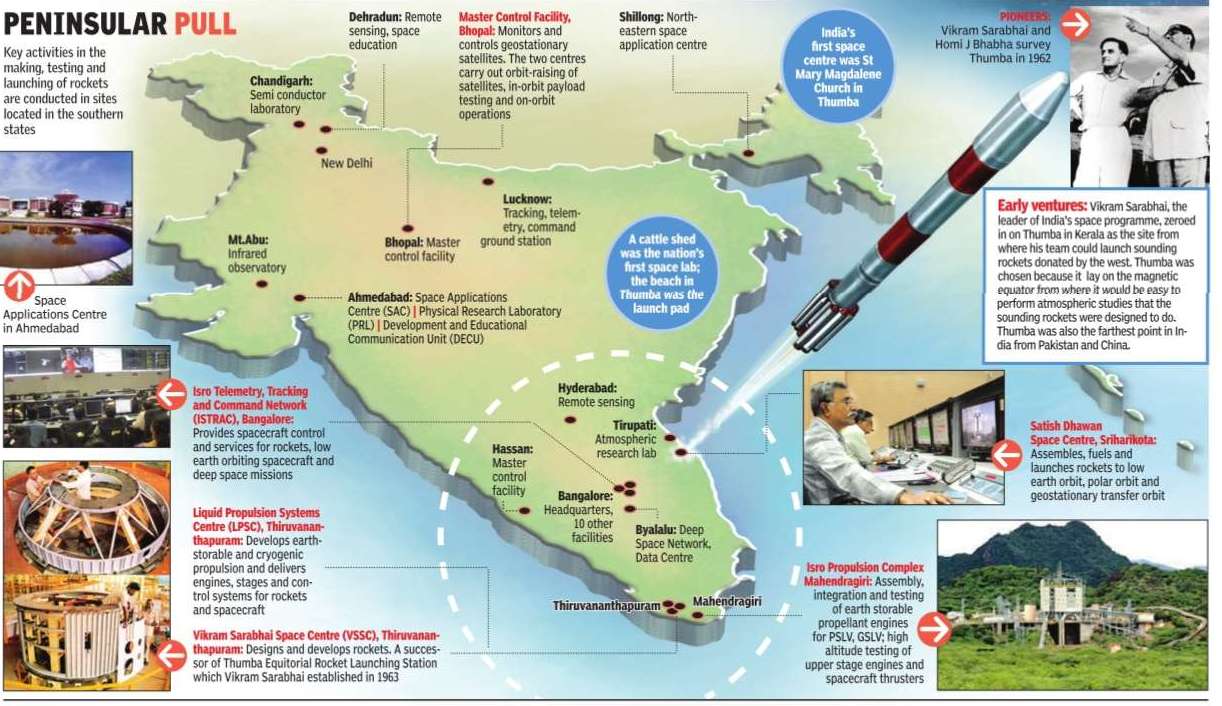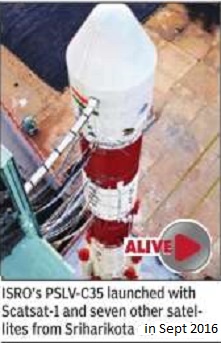Indian Space Research Organisation (ISRO)
(→2017: Missions) |
(→Jan 2017: Isro launches 104 satellites at one go) |
||
| Line 365: | Line 365: | ||
==Jan 2017: Isro launches 104 satellites at one go== | ==Jan 2017: Isro launches 104 satellites at one go== | ||
| − | [http://epaperbeta.timesofindia.com/Article.aspx?eid=31808&articlexml=Isro-launches-104-satellites-at-one-go-creates-16022017012001 U Tejonmayam & Srinivas Laxman | + | [http://epaperbeta.timesofindia.com/Article.aspx?eid=31808&articlexml=Isro-launches-104-satellites-at-one-go-creates-16022017012001 U Tejonmayam & Srinivas Laxman, 96 American Nanosats Piggyback On India's 714kg Cartosat, Feb 16, 2017: The Times of India] |
| − | , 96 American Nanosats Piggyback On India's 714kg Cartosat, Feb 16, 2017: The Times of India] | + | |
| − | + | ||
| + | [http://timesofindia.indiatimes.com/india/isros-record-satellites-launch-10-top-facts/articleshow/57159213.cms The Times of India], Feb 16, 2017 | ||
India broke a world record in space with the successful de ployment of 104 satellites in one go. The 104 satellites consisted of three Indian satellites -the 714 kg Cartosat-2 series satellite along with two other Indian satellites -and 101 international co-passengers which were nano and micro satellites. | India broke a world record in space with the successful de ployment of 104 satellites in one go. The 104 satellites consisted of three Indian satellites -the 714 kg Cartosat-2 series satellite along with two other Indian satellites -and 101 international co-passengers which were nano and micro satellites. | ||
The mission, which has attracted global interest, lifted off from the Satish Dhawan Space Centre at 9.28am.The rocket was the advanced version of the four-stage Polar Satellite Launch Vehicle called the PSLV-C37. | The mission, which has attracted global interest, lifted off from the Satish Dhawan Space Centre at 9.28am.The rocket was the advanced version of the four-stage Polar Satellite Launch Vehicle called the PSLV-C37. | ||
| + | |||
| + | |||
| + | ''In brief'' | ||
| + | |||
| + | 1. Of the 104 satellites ISRO launched today, three are Indian and 101 are foreign and smaller satellites. | ||
| + | |||
| + | 2. The space agency used the Polar Satellite Launch Vehicle (PSLV) for the launch. It carried a 714 kilogram main satellite for earth observation and 103 smaller "nano satellites" which weighed a combined 664 kilograms. | ||
| + | |||
| + | 3. Most of the nano satellites are from other countries, including from Israel, Kazakhstan, The Netherlands, Switzerland, United Arab Emirates and the US, said the state-run ISRO. A whopping 96 satellites are from the US alone. | ||
| + | |||
| + | 4. ISRO today beat the record+ held by Russia, which in 2014 catapulted 37 satellites in a single launch, using a modified inter-continental ballistic missile. | ||
| + | |||
| + | 5. In June 2016, India set a national record after it successfully launched a rocket carrying 20 satellites, including 13 from the US. | ||
| + | |||
| + | 6. The famously frugal ISRO hopes to set an enviable benchmark for the space fairing nations. In fact, in 2014, Prime Minister Narendra Modi quipped that an Indian rocket that launched four foreign satellites into orbit cost less to make than the Hollywood film "Gravity". | ||
| + | |||
| + | 7. Putting commercial satellites into space for a fee is a growing business sector. That's because phone, Internet and other companies, as well as countries, are seeking greater and more high-tech communications. | ||
| + | |||
| + | 8. ISRO sent an unmanned rocket to orbit Mars in 2013 at a cost of just $73 million, compared with NASA's Maven Mars mission which had a $671 million price tag. | ||
| + | |||
| + | 9. ISRO is also mulling the idea of missions to Jupiter and Venus. The second mission to Mars is tentatively slated for in 2021-2022 timeframe and as per existing plans it may well involve putting a robot on the surface of the Red Planet. | ||
| + | |||
| + | 10. The government is pleased with ISRO's progress and in the recently announced annual budget it gave the space agency a 23 per cent increase in its budget. | ||
For Isro it was a giant leap from 20 to 104. On June 22 2016, it had placed 20 satellites in orbit in a single shot which gave the organisation the confidence to raise the number.In Wednesday's mission the total weight of all the 104 satellites flown was 1,378 kg. | For Isro it was a giant leap from 20 to 104. On June 22 2016, it had placed 20 satellites in orbit in a single shot which gave the organisation the confidence to raise the number.In Wednesday's mission the total weight of all the 104 satellites flown was 1,378 kg. | ||
Revision as of 23:32, 22 March 2017

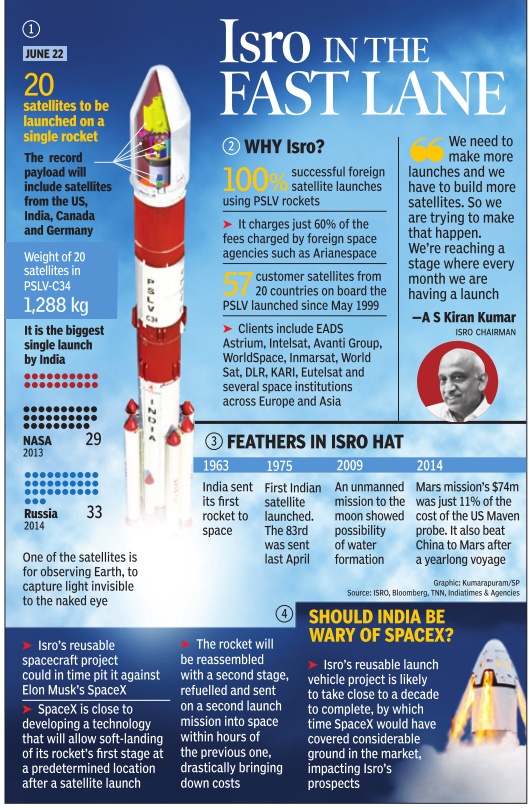
This is a collection of articles archived for the excellence of their content.
|
Milestones
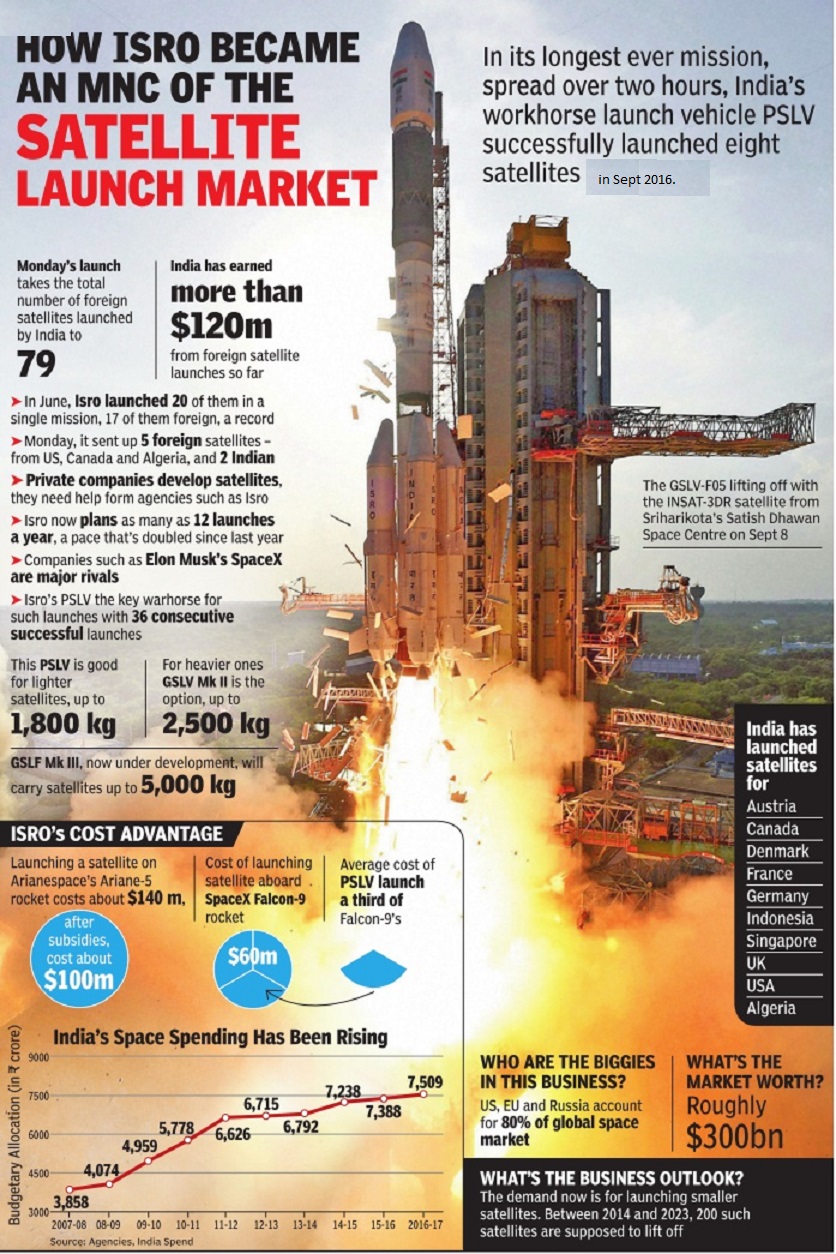
The Times of India
Hits and misses of Isro
Chethan Kumar,TNN The Times of India | Sep 24, 2014
Times of India tracks the journey of India’s space agency, the Indian Space Research Organization (Isro):
1: The sounding rocket might have been launched from Thumba Equatorial Rocket Launching Station (TERLS) as early as 1963, with Vikram Sarabhai being the visionary mind behind Indian space programme, but the Indian Space Research Organisation (Isro) was officially created on Aug 15, 1969. A new campus at Veli, Thiruvananthapuram was set up in the same year.
2: Just about 6 years from creation of Isro, the launch of the first Indian satellite, Aryabhata, happens on April 19, 1975. Several other landmarks like operationalising SHAR Centre in Sriharikota (1971) rechristened as Satish Dhawan Space Centre in October 2003; establishment of the Department of Space (DOS) on June 1, 1972 with Satish Dhawan as the Secretary, and, establishment of the Isro Satellite Centre in Bangalore (1972).
3: Four years after Aryabhata, Isro launches Bhaskara, an experimental satellite for earth observations on June 7, 1979, and the first experimental launch of SLV-3 (launch vehicle) was done on August 10 the same year. But the satellite failed to reach the orbit. Many experiments including multiple attempts of launching SLV-3 and other satellites happened over the next eight years, including the launch of the first INSAT system on August 30, 1983.
4: Basking in the glory of the achievements, Isro experimented with the launch of ASLV, an advanced version of SLV-3 on March 24, 1987. But the satellite (SROSS-1) failed to reach the orbit. This was followed by a successful launch of INSAT-1D on June 12, 1990, which preceded the launch of the second operational Remote Sensing Satellite on August 29, 1991.
5: 1993: First developmental launch of what is today called Isro's workhorse launch platform, the Polar Satellite Launch Vehicle (PSLV) began. Even the PSLV's first attempt to put a satellite into orbit failed on September 20, 1993 This was followed by many communication and remote sensing satellites in the 90s. Isro saw success with PSLV, even began development of the Geo-synchronous Satellite Launch Vehicle (GSLV). GSLV, in fact, placed GSAT-1 satellite in orbit on April 18, 2001.
6: 2008: Isro launches a record Cartosat-2A and IMS-1 along with eight nano satellites (DELFI-C3 for the Netherlands; CUTE-1.7 and SEEDS for Japan; CAN-X2 and NLS-5 for Canada; AAUSAT-II for Denmark; COMPASS-I and RUBIN for Germany). Landmark project Chandrayaan also saw its launch on October 22, 2008 aboard the PSLV-C11.
7: November 5, 2013, Isro sent a probe to Mars at a cost of Rs 450-crore.
8: As India gears up for her date with the Red Planet, Isro's first interplanetary mission, the space agency holds the credit of having put in place the largest (civilian) constellation of remote sensing satellites, with 10 of them currently working in space.
9: September 24, 2014: Mars Orbiter Mission to be inserted into the Martian Orbit.
1981: Apple and other early successes
The Times of India, Jun 21 2016
Chethan Kumar How an `Apple' on a bullock cart took Isro to stars
The Indian Space Research Organisation (Isro) has become one of the first picks for countries looking to launch satellites. The situation was not always like this.Thirty-five years ago, on June 19, 1981, Isro successfully launched its first communication satellite, Ariane Passenger PayLoad Experiment (Apple), on Ariane-1 from Kourou, French Guiana. This was a major milestone in India's space programme as Apple was used for several communication experiments, including relay of television programmes and radio networking. Incidentally , this satellite was transported on a bullock cart, captured for pos terity in an unforgettable photograph. It had only been six years since Aryabhatta, Isro's first satellite, and the agency was still in its infancy much like the country's infrastruc ture. Isro had been trying launch technology through its SLV class of launchers and the Satellite Telecommunication Experiments Project had been launched.
Bhaskara and Rohini had been successes before Apple.But Apple laid the foundation for indigenous development of operational communication satellites which grew into a very large constellation of satellites in Insat and Gsat series that spurred the country's technological and economic growth. Newer applications like tele-education, telemedicine, Village Resource Centre, Disaster Management System etc were enabled through space technology.
According to the book `Fishing Hamlet to Red Planet', although the satellite was laun ched through Ariane, Apple was boosted into Geo-Synchronous Orbit by Isro's own apogee motor derived from the fourth stage motor of the SLV-3. It kicked off Isro's impeccable record with deadlines. While the agency is known to have built the Mars Orbiter Mission in 18 months, it continued a long tradition and the agency had designed and built Apple in just two years with limited infrastructure in industrial sheds. Meanwhile, the final 48hour countdown to Isro's record-breaking mission, which will place 20 satellites -17 from abroad -in the same orbit, kicked off on Monday . The launch of the PSLV C-34 Cartosat-2 series satellite mission is slated for June 22 at Sriharikota.
Indigenous GPS system
The Times of India, Apr 29 2016
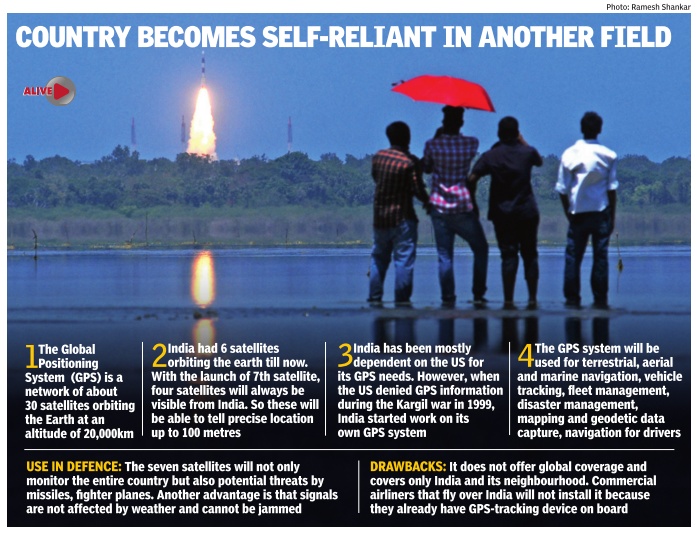
U Tejonmayam
India in elite club with own satnav
India joined an elite group of countries, including the US and Russia, with its own satellite navigation system, with Indian Space Research Organsation's (Isro) successful launch of PSLV-C33 delivering its payload, IRNSS-1G, the seventh and last in a constellation of satellites that make the indigenous GPS system.
An XL version of a Polar Satellite Launch Vehicle (PSLV-C33) placed the satellite in orbit around 20.19 minutes after lift off from Satish Dhawan Space Centre in Sriharikota at 12.50pm. Congratulating scientists on the successful launch, Prime Minister Narendra Modi said the new technology will not only help India but can also help the Saarc nations.
“The new technology will benefit our people, our fishermen,“ he said. “The world will know it as Navic.“
he said. Modi gave the expanded form of `NAVIC' as Navigation with Indian Constellation. The European Union and China, along with US and Russia, have indigenous satellite navigation systems.
IRNSS mission director B Jayakumar said the complete network of seven satellites will be fully functional within two months.
“The first six satellites in the orbit have already started functioning from their designated orbits,“ he said.
When the entire network becomes fully operational, it can provide navigation and positioning services to users via their smartphones and devices in vehicles with an expected positional accuracy of 20metres. It can also provide the service in areas that require high precision for marine navigation, rail transport, aviation and military applications with an ac curacy of 10m. But for the positioning service to reach the common man on a handheld device may take some time as it will require Isro's installation of additional hardware.
An Isro official said the space agency had developed a coded chipset that can be incorporated with an existing receiver of a smartphone or any positioning device on vehicles, ships or planes to communicate with the satellite and get position information.“But entrepreneurs have to step up and make these chipsets on a large scale,“ he said.
Isro has also been conducting meetings with navigation device manufacturers and mobile phone manufacturers to demonstrate how IRNSS could provide accurate information on par with US's GPS, which is the most widely used system in the world.
Compared to the US GPS, which has a precision of 5m and global coverage, IRNSS covers a 1,500-km radius with India at the centre. However, it will reduce India's dependence on the US and Russia's GLONASS particularly during emergencies including military situations.
The IRNSS project was envisioned after the US denied GPS information during the Kargil war. Further, scientists say that while GPS is not available at all places, the indigenous system will provide signal even in remote areas with better accuracy.
Manned mission
Crew module test
The Times of India, Nov 30 2014
Binoy Valsan
Scientists at the Satish Dhawan Space Centre in Sriharikota were busy integrating a brown bucket-like structure with a black lid mounted on a pedestal.Some day soon, they believe, an improved version of this would carry people to space. Indian Space Research Organisation (ISRO) took baby steps towards sending man to space, with an experimental flight of a GSLV-Mark III all set to carry this `crew module' as the payload in the sec ond week of December. While the manned mission is at least 10 years away , a full-fledged flight of GSLV-MIII is also a couple of years away . The biggest rocket to be made by ISRO, it can carry payloads up to four tonne-a necessity in the coming days of heavy satellites. Scientists are testing indigenously developed cryogenic engine at Isro's Mahendragiri facility.
The unmanned module to be used in Crew Module Atmospheric Re-entry Experiment (CARE) is to test its ability to re-enter the atmosphere with thermal resistance, parachute deployment in cluster formation, aero braking system and apex cover separation procedures.
Major ISRO centres
Feb 20 2015 Arun Ram
Geography, history and logistics have necessitated the positioning of 14 of 20 major ISRO centres in the region
In the 1960s, when children of coastal Thiruvananthapuram remained outdoors even after nightfall, mothers employed a scare: “Get in, Maadan would be flying now.“ Maadan, the not-so-friendly local god would fly with a mace at night, spewing fire and threatening to knock down those who disobeyed parents. For those disbelieving kids, the women would point to the night sky and show the occasional ball of fire that disappeared in seconds. Later in high school, science teachers called the mothers' bluff. The fire ball, they told the students, was the flare of sounding rockets fired from the neighbouring Thumba Equitorial Rocket Launching Station. The 30kg-something rockets would go up to an altitude of 60km, and the tiny payloads, before plunging into the Arabian Sea, would do some atmospheric studies.
From flying tiny sounding rockets gifted by the US, the USSR and France in the 1960s to launching satellites weighing up to a couple of tonnes into geosynchronous transfer orbits from the Satish Dhawan Space Centre in Sriharikota, India has come a long way . With that has grown the Indian Space Research Organisation (Isro) that today has centres across the country . But the southern peninsula remains the hub of India's rocket-making, testing, flying and tracking.
Sample this: Out of the 20 major Isro centres, 14 are situated in the southern states . While a large majority of these centres handle strategic operations, the others are mostly involved in research, education, training and analysis.
So why this geographical dichotomy? The answer lies not in parochialism, but in a combination of science, history and logistics. To know this concentration of Isro branches, we should look at the roots of India's space programme.
When Jawaharlal Nehru, on the advice of Homi J Bhabha, formed the Indian National Committee for Space Research (Incospar) in 1962, its leader Vikram Sarabhai's first assignment was to identify a place from where India could launch borrowed sounding rockets.
To carry out atmospheric stud ies, the best place would be somewhere near the magnetic equator of the Earth which ran close to the southern tip of the country. And this led Sarabhai and Bhabha to Kerala, where they zeroed in on Thumba, then a sleepy fishing village. There was not even a proper building in Thumba, but Sarabhai was in a hurry . In 1963, he moved his small team that included H G S Murthy ,D Eswar Das, M R Kurup and A P J Abdul Kalam to the St Mary Magdalene's Church.
Murthy, who headed the team, had an office in the Bishop's house. The remaining scientists, later joined by S Nambinarayanan, put together four tables in the church building to mount their drawing boards. A cattle shed doubled up as their laboratory , the coconut palmfringed beach their test pad.
After experimenting with foreign sounding rockets, when Incospar became Isro in 1969, it was time for indigenous rocket launches. And it needed a bigger launch pad on the eastern coast, for future satellite launches would need an eastward launch to go against the Earth's spin.Sriharikota, 100km north of Chen nai, on the Andhra Pradesh side was identified. The island had Bay of Bengal on one side and the Pulicat lagoon on the other three. This meant that even if a rocket went out of control, it could be destroyed above the sea, with minimum risk to people.
Soon, a liquid propulsion centre came up in Thiruvananthapuram and, after Sarabhai's untimely death in 1971, all the facilities in the Kerala capital became the Vikram Sarabhai Space Centre (VSSC). When Isro wanted a facility to test its rocket engines made in Thiruvananthapuram, Mahendragiri in neigh bouring Tamil Nadu became a natural choice because of the proximity and the hilly topography.
For administrative purposes, Bangalore had become the Isro headquarters, and being equidistant from VSSC and Sriharikota helped. This also led to many auxiliary offices cropping up around Bangalore, including the Isro Telemetry Tracking and Command Network headquarters and the Isro Satellite Centre.When India needed a deep space tracking centre, Byalalu, a remote place in Karnataka was chosen for its sparse population and the result ant low electromagnetic interference.Hyderabad became the nerve centre of remote sensing, probably for its central location.
Isro centres in the northern states provide basic research and payloads. Physical Research Laboratory, Ahmedabad, does high-end studies in astrophysics, while Space Applications Centre in the same city makes satellites and other payloads.Once the satellite is in space, north and south equally count, and hence the regional remote sensing centres and tracking centres across the country . For controlling geostation ary satellites, Isro has a master control facility each in Hassan, in Karnataka, and Bhopal.
Still, as India's rockets continue to be made, tested and fired in the south, there remains an open secret that Isro scientists don't tell you. In 1962, when Vikram Sarabhai's search for the perfect place near the Earth's magnetic equator took him to Thumba, the great man wouldn't have suppressed a smile when he realized it was also the farthest point from Pakistan and China.
Maadan, obviously, posed a much lesser risk.
Antrix, ISRO's commercial arm
Devas contract, its scrapping and Rs 4,435cr fine
The Times of India, Oct 01 2015
Int'l tribunal slaps Rs 4,435cr fine on Antrix
Isro Arm Had Aborted Devas Deal In 2011 Antrix and Devas had signed a contract to launch two satellites and use spectrum. However, after a controversy over procedural lapses led to blacklisting of four Isro scientists, including ex-Isro chief Madhavan Nair (above), the govt had scrapped the deal Isro's commercial arm, Antrix, has termed the international arbitration court ruling asking Isro to pay Rs 4,435 crore ($672 million) in damages to Bengaluru-based Devas Multimedia as shocking. “Antrix, with the support of the department of space, is preparing to file in court its application for remedy ,“ said an Antrix statement.
The tribunal's ruling on Tuesday is not yet binding on the Indian space agency , as Devas would require to get the ruling enforced by an Indian court. In a statement, Devas Multimedia said: “Devas Multimedia and its shareholders, including highly regarded international investors, are pleased that the ICC Tribunal unanimously ruled in its favour and found that Antrix is liable for unlawfully terminating the Devas-Antrix Agreement in February 2011.“
It said that Devas is hopeful that Antrix will now live up to its legal obligations and pay the award so that this dispute that arose during the prior government can be brought to a swift closure.
The contract signed between Devas and Antrix was to launch two operating satellites and use spectrum that is licensed to the firm.
However, following a controversy of lapse in procedures that led to blacklisting of four Isro scientists, including ex-chairman Madhavan Nair, the government scrapped this deal. This prompted Devas to take the legal course.
Devas was to lease 70 MHz of S-band spectrum from two satellites that were to be launched by Isro and pay $300 million for the rights.
2016: Indiainches closer to its own GPS
The Times of India, Jan 21 2016
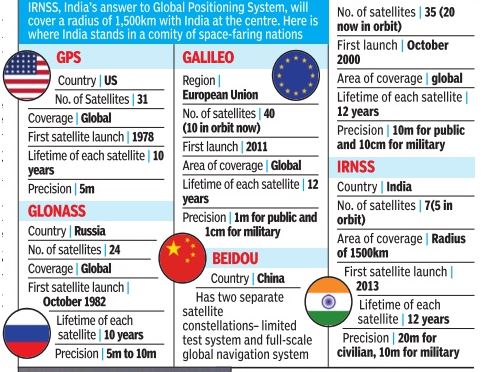
U Tejonmayam
SEVEN-SAT SYSTEM - 5th navigation sat takes India closer to `desi GPS' Indian Space Research Organisation (Isro) has started 2016 with a bang, launching the fifth (IRNSS-1E) naviga tion satellite in the Indian Regional Navigation Satellite System (IRNSS) constellation that will function as an alternative to the US-owned Global Positioning System (GPS).
An XL version of a Polar Satellite Launch Vehicle (PSLV-C31) placed in orbit the satellite 19.36 minutes after liftoff from the Satish Dhawan Space Centre in Sriharikota.
IRNSS will provide navigation and positioning services in areas that require high precision for aviation, marine navigation, rail transport and military applications.In six-months, Isro expects the system to be integrated with smartphones.
Foreign exchange earnings, 2013-15
See graphic
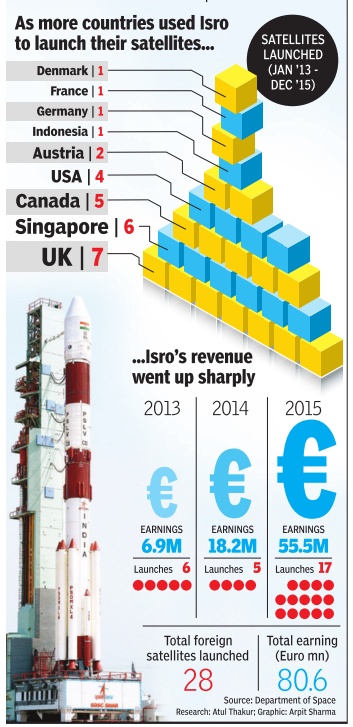
GSLV
2016: 1st indigenous cryogenic engine
The Times of India, Sep 09 2016
U Tejonmayam
India launches 1st operational GSLV using indigenous cryogenic engine
After more than two decades of toiling over the Indian cryogenic engine programme, the Indian Space Research Organisation (Isro) successfully registered the first operational flight of a Geosynchronous Satellite Launch Vehicle using an indigenous cryogenic engine.
GSLV-F05, powered by the CE-7 engine, lifted off from Sriharikota at 4.50pm -40 minutes behind schedule because of a gas leak in the ground circuit. About 17 minutes later, the rocket put in orbit INSAT-3DR, India's third exclusive meteorological satellite.Isro scientists at the earth station will fire the thrusters of the 2,211kg satellite to move it from a geosychronous transfer orbit to its final geostationary orbit in the next two days.
Isro chief A S Kiran Kumar said the launch has given confidence to take up two GSLV launches every year.“This has demonstrated our cryogenic capabilities. The next launch is planned in March 2017,“ he said. GSLV enables India to put in orbit satellites heavier than 2 tonnes, and bring in revenue through commercial launches.
It was the GSLV's 10th flight, and the fourth using the indigenous engine (the first three were developmental flights). Liquid Propulsion Systems Centre director S Somanath said, “Cryogenics does not scare us anymore. We are building a bigger engine called C35.“ With this, Isro is targeting a quantum leap in commercial launches. And the logical progression would be to GSLV-MIII which can carry payloads weighing up to 4,000kg to a geosynchronous transfer orbit.
Spacecrafts, industry-built
The Hindu, December 11, 2016
The Indian Space Research Organisation (ISRO) has signed the first contract for an industry-built spacecraft with a consortium of six companies based in Bengaluru.
The contract includes the assembly, integration and testing (AIT) of two spare navigation satellites in 18 months. It was signed between M. Annadurai, director of ISRO Satellite Centre (ISAC), and the consortium lead, Alpha Design Technologies P Ltd.
ISAC assembles the country's satellites for communication, remote sensing and navigation.
While ISRO has purchased sub-systems from its suppliers, this is the first time that it will be outsourcing entire satellites to industry, Col. Shankar said.
Alpha is a defence manufacturing contractor while the others are small and medium-sized companies which already supply components to ISRO's programmes.
In the coming days, ISAC will train about 70 skilled personnel from the six companies at its facilities in building the first satellite, which is to be completed in about nine months.
"The second spacecraft will be made entirely by us but at ISRO's readily available facilities. From the second year onwards, the consortium must provide four to five [small- to medium-sized] satellites each year," Col. Shankar said.
ISAC said, "In order to meet the growing demands of satellites realisation, ISAC has been looking [for] active participation of industry in assembly, integration and testing of standard ISRO satellites. As part of this initiative, a contract was awarded to a consortium of six companies led by Alpha Design Technologies Private Ltd."
Dr. Annadurai had said in September that two spare navigation satellites would be the first lot to be outsourced. The seven-satellite Indian Regional Navigation Satellite System (IRNSS) is already in orbit, awaiting formal operations.
ISRO Chairman A.S.Kiran Kumar has frequently spoken about backlog of satellite production in the midst of galloping demands; the need is to double the number if ISRO must meet the requirements of all its users in communication, remote-sensing and the new navigation satellites.
The space agency had hosted a few vendor meetings to find partners to build its satellites.
Col. Shankar said over the next two years, the company planned to invest Rs. 150 crore to set up new, dedicated facilities near ISRO's Spacecraft Integration Test Establishment (ISITE) here in Marathhalli. It had already put in Rs. 20 crore in the next 18 months.
The others in the consortium are Newtech Solutions; Aidin Technologies and DCX Cables from Bengaluru; Vinyas Technologies from Mysuru and Avantel Systems of Hyderabad.
2016
April 2016: PSLV C33
The Hindu, April 29, 2016
Avinash Bhat
ISRO’s workhorse PSLV C33, carrying India's seventh navigation satellite IRNSS-1G, soars into the sky after its launch from the Satish Dhawan Space Centre in Sriharikota near Chennai on Thursday. Photo: K. Pichumani The Hindu ISRO’s workhorse PSLV C33, carrying India's seventh navigation satellite IRNSS-1G, soars into the sky after its launch from the Satish Dhawan Space Centre in Sriharikota near Chennai.
A regional navigation satellite system with just seven spacecraft and in civil domain is unique to India.
India’s own navigational system, the set-up for which was completed on Thursday with the launch of the seventh and final satellite, will be called NAVIC (Navigation with Indian Constellation), Prime Minister Narendra Modi announced after the launch.
The seventh and final satellite of the Indian Regional Navigation Satellite System, the IRNSS 1G, was launched into a sub geosynchronous transfer orbit with a perigree (nearest point to earth) of 284 km and an apogee (farthest point to earth) of 20,657 km. The satellite was launched on board the Polar Satellite Launch Vehicle (PSLV), which took off from the Sriharikota launch pad at 12.50 p.m.
With this launch, the IRNSS constellation of seven satellites is now complete. This will allow the Indian Space Research Organisation (ISRO) to focus on the process of designing front end chips which will receive the navigational signals sent out by the satellites. The system will be similar to the Global Positioning System (GPS) operated by the United States with 24 satellites and the Glonass, Galileo and BeiDou systems of Russia, Europe and China respectively.
All satellites will undergo stabilisation testing and verification of their performance over the next few months before being pushed into use, according to ISRO officials.
An area of 1,500 km from Indian boundaries will be covered under the navigational system. The Prime Minister invited other countries to make use of this system as well. “We have seven neighbours who rely on technology provided by other countries. They can use Indian services if they want,” he said in a video message addressed to ISRO engineers.
With an accuracy of better than 20 m being claimed by ISRO, the navigation system will be offered as an open or Standard Positioning Service and a superior, coded military Restricted Service.
“We are now one of five countries with our own navigational system. Today we are free of dependence on other countries for navigation. Our planes will be able to land with ease and accuracy, we can plan disaster relief better and with our own technology,” a proud Mr. Modi said.
Explaining the name NAVIC, Mr. Modi said the system was dedicated to India’s mariners and fishermen who have been navigating using the sun and stars as waypoints for hundreds of years. “They have shown strength and determination in venturing out to sea for so many years. We have named this system for them, the ‘naviks’ (mariners),” he said.
June 2016
Inject a record 20 satellites at a time into orbit
The Times of India, Jun 23 2016
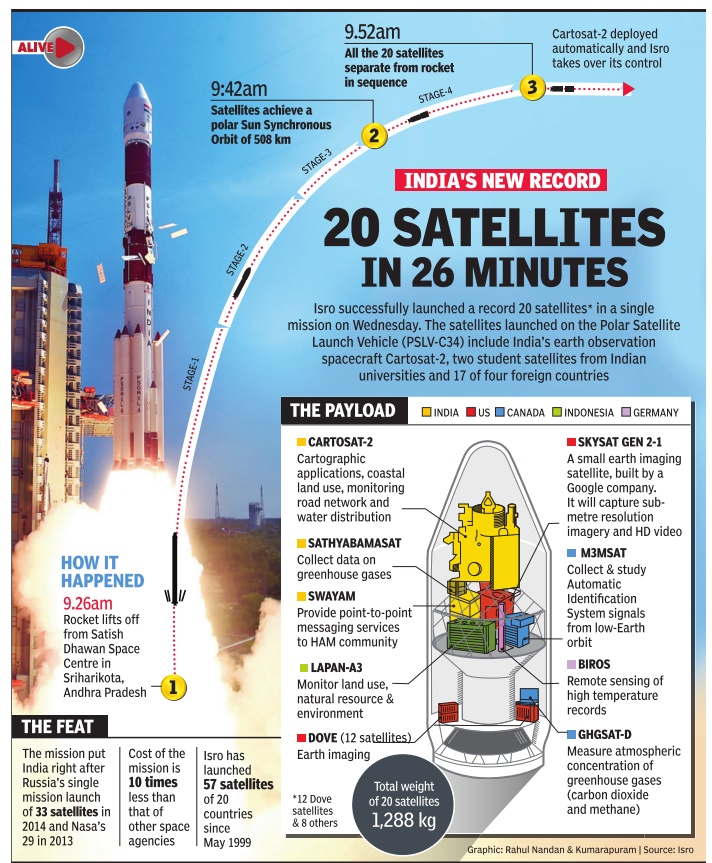
U Tejonmayam
Isro record: 20 satellites take off at one go India's PSLVC34 rocket circled the earth in about 90 minutes, at 7.7km per second, to inject a record 20 satellites into orbit and demonstrate its capability to reach another orbit in the same mission. The `XL' version of the 320-tonne spacecraft lifted off from Satish Dhawan Space Centre at Sriharikota with payloads weighing 1,288kg at 9.26am. India's remote sensing satellite Cartosat-2C, weighing 727.5kg, sat on the top part of the PSLV's nose cone; riding piggyback were two Indian student satellites and 17 earth observation satellites from the US, Canada, Germany and Indonesia. Prime Minister Narend ra Modi called it a mo numental accomplishment. “20 satellites in a go! @isro continues to break new barriers. Hearty congratulations to our scientists on the monumental accomplishment,“ he tweeted. “PSLV has done its job again,“ said Isro chairman A S Kiran Kumar.
About 17 minutes after lift-off, the rocket began injecting satellites, starting with its Cartosat-2C. In the next 10 minutes, PSLV made several manoeuvres to inject all the satellites in a single orbit in different inclinations and with varying velocity, in the process travelling halfway around the earth.
Isro also used the occasion to test its capability to launch multiple satellites into different orbits.
About 50 minutes after launching all the satellites, the fourth stage reignited for five seconds before travelling around the earth for 45 minutes, completing a full circle.
The demonstration was conducted for Isro's next mission, when it plans to launch five satellites in two different orbits.
Mission director B Jayakumar said that multiple launches in a single mission required complex technology and Isro is working on resolving certain problems that may arise during such launches. “Initially we were a little hesitant to take 20 satellites in one go. But we soon resolved the problems,“ he said.
“What we have achieved today shows we have the expertise to take up complex missions,“ Jayakumar said.
Isro set a world record for the highest number of satellites launched in a single mission when it placed 10 satellites in a PSLV on April 28, 2008.Nasa in 2013 placed 29 satellites in a single mission and Russia in 2014 launched 33 satellites in one launch.
Sept 2016: PSLV-C35 launches eight satellites in multiple orbits
U Tejonmayam, In its longest flight, PSLV puts 8 sats into orbit, Sep 27 2016 : The Times of India
With its engine turned off for much of the mission's duration of two hours and 15 minutes on Monday , the PSLV-C35 glided its way not just across the earth, but also the annals of India's spacefaring history -placing eight satellites in multiple orbits along the way .
The rocket had two coasting periods which together lasted for more than 1.5 hours after its engine was reignited and shut down twice.
Monday's launch was the PSLV's longest flight.Among the satellites it put into orbit were two developed at Indian universities -Pratham by students of IIT-Bombay and PISAT by the PES University , Bengaluru, and its consortium. In its longest-ever flight, the PSLV C-35, carrying India's Scatsat-1 meant for ocean and weather studies among seven satellites including those from the US and Canada, lifted off from the Satish Dhawan Space Centre in Sriharikota.
About 100 minutes after the Scatsat-1 was put into orbit, seven other satellites were placed in the other polar orbit.
“We were able to put differ ent satellites from different countries in different orbits in different local times. We have so far launched 79 satellites from 21 countries,“ said Isro chairman A S Kiran Kumar.
When PSLV-C35 placed Scatsat-1 in the polar synchro nous orbit 17 minutes after liftoff from Sriharikota, both the satellite and the rocket began to circle the earth.
About 66 minutes later, the rocket's fourth-stage engine was reignited and shut down for about 20 seconds, as a preparation to switching orbits and launching the rest of the satellites. The shutdown gave the necessary thrust for the rocket to manoeuvre further and change orbits -from polar sun synchronous to polar orbit. The rocket was coasting at a speed of about 27,000km per hour.
The engine was restarted and cut off for 20 seconds, about 45 minutes after it coasted for the second time during its mission. A minute later, seven other satellites were placed in orbit one after the other within 3.45 minutes.“PSLV launches usually last 20 to 25 minutes. But this launch lasted nearly two-anda-half hours. It was almost like having two separate launches,“ said B Jayakumar, mission director. Very few space-faring countries have achieved this feat. European Space Agency's Vega rocket recently accomplished a twin-orbit manoeuvre. “One side of the rocket was getting hot, as it was facing the sun while the other side was using heat to move,“ Jayakumar said. He added that PSLV now has the flexibility to suit customers' demands.
Isro chairman said an Algerian team, which witnessed the launch of its satellites on Monday , has shown interest in using Indian launch vehicles.
Isro's commercial arm Antrix Corporation has orders worth Rs280 crore from countries wanting to launch satellites. “We had a turnover of Rs1,790 crore this year and Rs1,717 crore last year,“ said Isro Propulsion Complex director S Rakesh. 1st satellite by IIT students enters orbit A t 11.26 am on Monday, Mumbai rocketed into the space age when Pratham, a 10 kg satellite, developed by students of IIT-Mumbai, went into orbit. It was the first satellite made in Mumbai.
Manvi Dhawan, a project manager, explained that the primary role of Pratham would be to do what is known as a total electron count of the ionosphere. In plain terms this will help to correct GPS signals and rectify navigation.
Antrix Corporation Ltd
Commercial services
2014-16
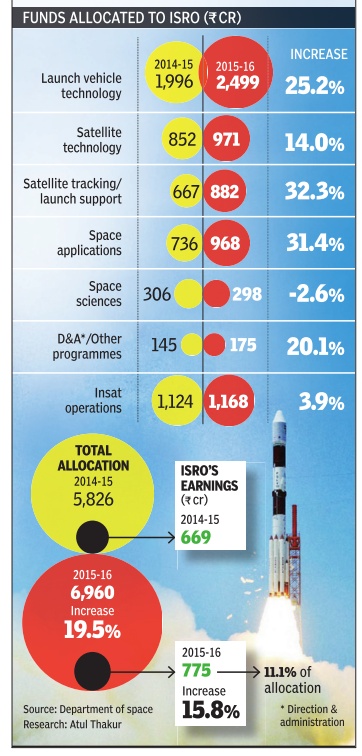
Antrix-Devas deal
Cancelled in 2011
The Times of India, Aug 12, 2016
Antrix deal was cancelled in 2011
The CBI filed a chargesheet against Isro's former chairman G Madhavan Nair, former executive director of Antrix Corporation R Sridhara Murthi and a US firm in the controversial Antrix-Devas deal. The contract for leasing S-band spectrum was given to an “ineligible company“ without informing the government, which led to a loss of Rs 578 crore, CBI said. The development comes days after the Permanent Court of Arbitration tribunal at The Hague ruled against India and said it was liable to pay compensation to foreign investors in De vas Multimedia.
The CBI said Nair kept the then Manmo han Singh Cabinet in the dark and gave wrong information about the deal. Nair rubbished the charge and said scientists were made “scapegoats“ in the case. The agency had questioned him earlier this year over his “conflict of interest“ in the deal. Nair was chairman of Antrix's governing council and secretary , department of space, when the deal was finalised.He was barred from holding any government post for his alleged role in the deal.
Devas had entered into an agreement with Antrix Corporation, the commercial arm of Isro, in 2005 to lease almost the entire transponder space on two of its satellites, and nearly half of the S-band spectrum under its control.The government had cancelled the deal in 2011 after a CAG report questioned it.
In an exclusive interview to TOI in March 2015, Nair had said the Antrix-Devas deal came under the scanner because “there was a panicky reaction from the PMO (then headed by Manmohan Singh) since 2G scam dented the government's image“.
In its chargesheet, the CBI named Nair, Murthi, Ramachandra Vishwanathan (former MD of Forge Advisors LLC USA & CEO of Devas Multimedia), M G Chandrasekhar (then director of Devas), Veena S Rao (then additional secretary in department of space), A Bhaskar Narayana Rao (then director in Isro) and D Venugopal and M Umesh (directors in Devas) for criminal conspiracy and cheating.
2016
The Economic Times , 26 Jul, 2016
By Gaurav Laghate & Maulik Vyas
Antrix-Devas deal: India loses arbitration in Hague
Indian government may have to shell out over a billion dollars in damages to Bengaluru-based Devas Multimedia, after an international court of arbitration ruled in favour of the company in case related to cancellation of a contract with Antrix Corporation, the commercial arm of Indian Space Research Organisation (ISRO).
The Permanent Court of Arbitration (PCA) tribunal at The Hague found that the government of India's actions in "annulling a contract between Devas and Antrix and denying Devas commercial use of S-band spectrum constituted an expropriation," Devas said in a statement on Tuesday.
It added PCA agreed that the Indian Government expropriated investments of Devas' foreign shareholders and acted unfairly and inequitably, thus making it liable to pay financial compensation.
This is not the first time that an international court has ruled against the government in Devas case. Last year, the International Chamber of Commerce's International Court of Arbitration (ICA) had ruled against Antrix, for "unlawfully terminating" Devas-Antrix agreement in 2011, directing the agency to pay $672 million (over Rs 4,400 crore) plus an annual interest accruing at 18 per cent post award, till it is paid in full, to Devas Multimedia.
However, after this PCA ruling, Devas will now have to take a decision as to whether or not to enforce this award against ISRO/Government of India. Abhishek Malhotra, managing partner at the law firm TMT Law Practice said, "In the event that Devas decides to enforce this award in Indian Courts, the only defence that ISRO would have is Section 34 of the Arbitration and Conciliation Act, 1996, i.e., to say that this decision is against public policy of India."
He added that ISRO will have to demonstrate that the security-related and conflict of interest issues that led to cancellation of the agreement with Devas were of paramount importance and hence public policy considerations required cancellation thereof.
Accordingly, allowing such an award to be enforced would conflict with public policy considerations. Or it will have to prove that the quantum of damages awarded is inconsistent with Section 73 of Indian Contract Act, 1872, which only allowed for compensatory damages to be awarded.
"Whether Devas wins or loses its enforcement battle, the judgment does have the effect of bringing under cloud India's efforts to become an appealing destination for ease of doing business," Malhotra added.
Madhavan Nair, former ISRO chief, who was with the Department of Space when the deal was signed, told ANI, "It is all because of the illegal action taken by the UPA 2 government and the Department of Space at the time." He added that procedures were not followed while cancelling the contract.
"The tribunal ruled 60 per cent in favour of India, and 40 per cent against and no amount was determined to be due at this stage on the 40 per cent. That will be the subject of a second phase of the case. which has not yet begun. There is no deadline for the second phase, which will likely last at least a year and perhaps longer," said George Kahale III, partner, Curtis, Mallet- Prevost, Colt & Mosle LLp, a firm that is representing government of India in the dispute. "We are reviewing the options for legal recourse because we believe the entire case, not just 60 per cent, should have been dismissed."
The case dates back to 2005, when Antrix and Devas signed an agreement wherein the latter was to get about 70 MHz of S-band satellite spectrum to provide high-quality telephony and Internet services.
August 2016: First rocket using scramjet engine
The Hindu, August 20, 2016
The Indian Space Research Organisation joined an elite club when it successfully launched a rocket using a scramjet engine that was developed indigenously. This is ISRO’s first major step towards developing an air breathing propulsion system. The scramjet engine functioned for around six seconds. There are many reasons why the use of a scramjet engine is so attractive.
The test flight, which attained six times the speed of sound (Mach 6) and was able to achieve ignition and maintain stable combustion even at such high velocity for about six seconds, is a big technological achievement. This is akin to “lighting a matchstick in a hurricane condition and sustaining the flame” for six seconds. The air intake mechanism and fuel injection systems were also successfully demonstrated during the maiden test flight. Since it relies on oxygen present in the atmosphere, the trajectories of scramjet engine-powered rockets are vastly different from conventional ones — rockets with scramjet engines should remain in the atmosphere for a longer period than normal rockets.
What is a scramjet engine?
A scramjet engine uses oxygen present in the atmospheric air to burn the hydrogen fuel. As a result, the amount of oxygen required to be carried on board would be reduced considerably as atmospheric oxygen is utilised to burn the fuel in the first stage. In general, propellant accounts for nearly 85 per cent of the weight of a rocket, and oxygen accounts for nearly 60 per cent of the weight of the propellant. Scramjet-powered rockets also have several times greater thrust compared with rockets powered by liquid fuel or even cryogenic fuel. Since about half of the propellant is required for the first stage to achieve the required velocity, a rocket using a scramjet engine would be significantly lighter and smaller and, therefore, cheaper. Alternatively, rockets fired by scramjet engines will be able to carry more payload. Typically, scramjet rockets climb to a certain altitude and remain in the atmosphere for as long as possible to achieve the required velocity. It will take many years before a commercial rocket powered by a scramjet engine takes to the sky as there are several challenges to be overcome. One challenge will be to test the engine at higher Mach speeds and prolong the period of combustion. Since the scramjet comes into play only when the rocket goes beyond Mach 5, an engine that initially works at subsonic speed (as a ramjet) and later as a scramjet has to be developed. But as in the case of the successful test flight of a reusable vehicle, the first experimental flight using a scramjet engine is a technological demonstration of ISRO’s capability and will go a long way in redefining its position as one of the leading space agencies in the world.
2017: Missions
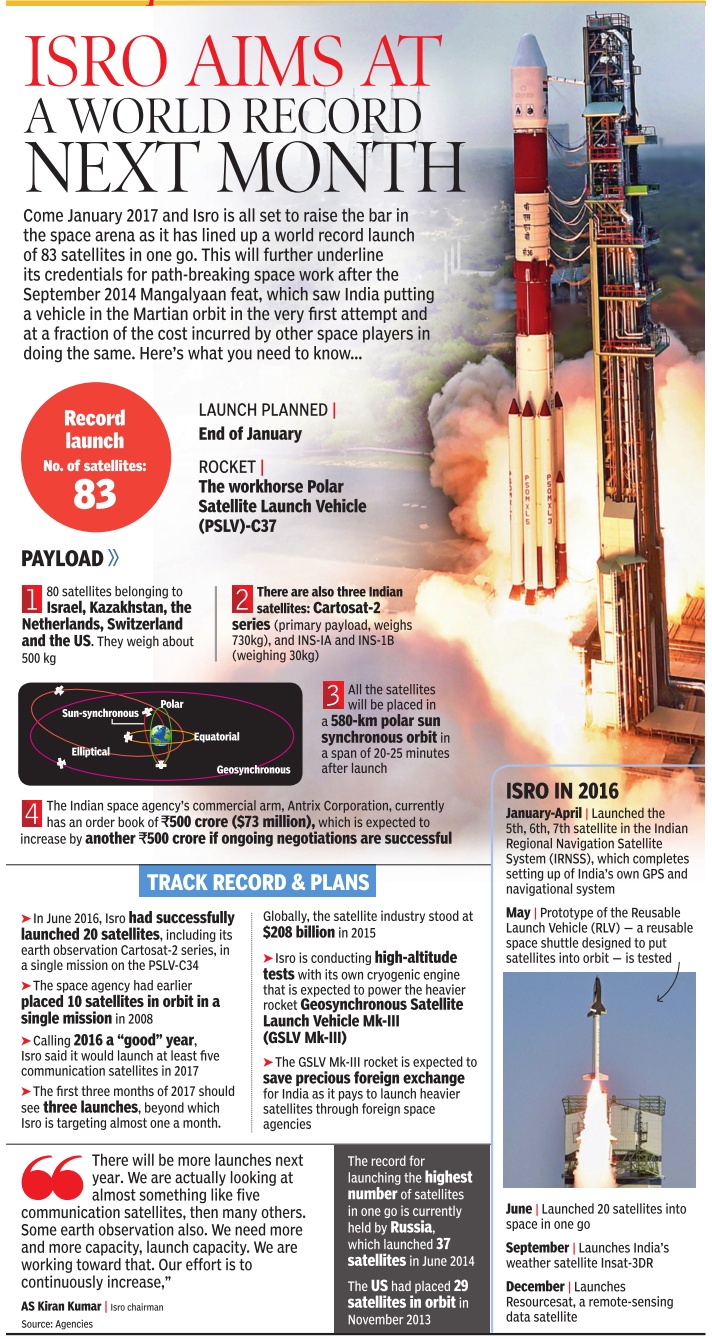
Jan 2017: Isro launches 104 satellites at one go
The Times of India, Feb 16, 2017
India broke a world record in space with the successful de ployment of 104 satellites in one go. The 104 satellites consisted of three Indian satellites -the 714 kg Cartosat-2 series satellite along with two other Indian satellites -and 101 international co-passengers which were nano and micro satellites.
The mission, which has attracted global interest, lifted off from the Satish Dhawan Space Centre at 9.28am.The rocket was the advanced version of the four-stage Polar Satellite Launch Vehicle called the PSLV-C37.
In brief
1. Of the 104 satellites ISRO launched today, three are Indian and 101 are foreign and smaller satellites.
2. The space agency used the Polar Satellite Launch Vehicle (PSLV) for the launch. It carried a 714 kilogram main satellite for earth observation and 103 smaller "nano satellites" which weighed a combined 664 kilograms.
3. Most of the nano satellites are from other countries, including from Israel, Kazakhstan, The Netherlands, Switzerland, United Arab Emirates and the US, said the state-run ISRO. A whopping 96 satellites are from the US alone.
4. ISRO today beat the record+ held by Russia, which in 2014 catapulted 37 satellites in a single launch, using a modified inter-continental ballistic missile.
5. In June 2016, India set a national record after it successfully launched a rocket carrying 20 satellites, including 13 from the US.
6. The famously frugal ISRO hopes to set an enviable benchmark for the space fairing nations. In fact, in 2014, Prime Minister Narendra Modi quipped that an Indian rocket that launched four foreign satellites into orbit cost less to make than the Hollywood film "Gravity".
7. Putting commercial satellites into space for a fee is a growing business sector. That's because phone, Internet and other companies, as well as countries, are seeking greater and more high-tech communications.
8. ISRO sent an unmanned rocket to orbit Mars in 2013 at a cost of just $73 million, compared with NASA's Maven Mars mission which had a $671 million price tag.
9. ISRO is also mulling the idea of missions to Jupiter and Venus. The second mission to Mars is tentatively slated for in 2021-2022 timeframe and as per existing plans it may well involve putting a robot on the surface of the Red Planet.
10. The government is pleased with ISRO's progress and in the recently announced annual budget it gave the space agency a 23 per cent increase in its budget.
For Isro it was a giant leap from 20 to 104. On June 22 2016, it had placed 20 satellites in orbit in a single shot which gave the organisation the confidence to raise the number.In Wednesday's mission the total weight of all the 104 satellites flown was 1,378 kg.
After the launch both the President and Prime Minister Narendra Modi congratulated the premier space organisation. “This remarkable feat by Isro is yet another proud moment for our space scientific community and the nation.India salutes our scientists,“ said Modi while congratulating Kumar over phone.
Isro chairman A S Kiran Kumar and mission director B Jayakumar told the media post the launch that the main challenge was the deployment of the 104 satellites in orbit so that they do not collide.
They said the foreign satellites were placed in quadrapacks, which are like small boxes. Once these quadrapacks were released from the rocket, the satellites were thereafter released in a timesequence manner. “The deployment went off flawlessly and we got a good response from the international customers,“ Kiran Kumar said. He emphasised that mission was not to break any records, but to utilise the extra capacity in the PSLV .
The chairman also said the other challenge was adhering to the timeframe demanded by the customers. He said this was also achieved.Jayakumar had earlier told TOI that the success of the mission would ensure a larger share for India in the global satellite market. “It is a combination of technology and commerce,“ he said. So far, of the 226 satellites launched through PSLV , 180 belonged to other countries.
Around 16 minutes and 48 seconds after the lift-off, the rocket began injecting satellites. In the succeeding 12 minutes all the 104 satellites separated from the PSLV .
Veteran space scientist K Kasturirangan also hailed the record launch, terming it as a remarkable feat and spectacular success demonstrat ing to the world India's capability in the field.
“I admire Isro for having done this and demonstrated to the world that we can launch more than 100 satellites in a single shot“, the for mer chair man of the country's premier space research organisation said.
